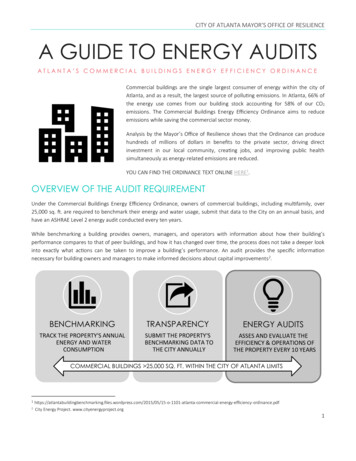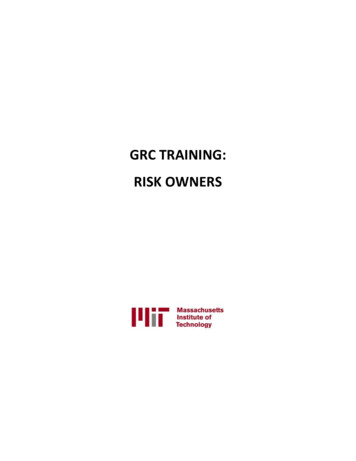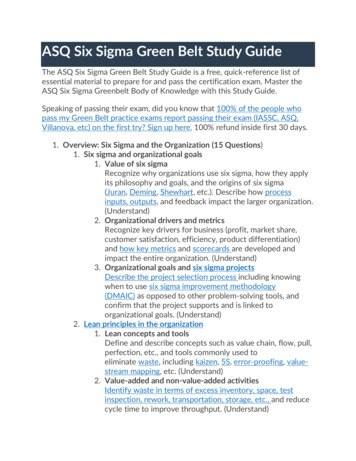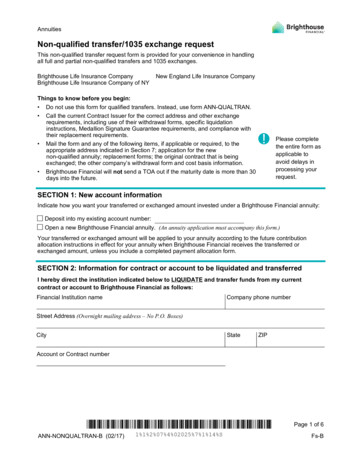
Transcription
THE SCOOTDAWGCOMPLETE OWNER SMANUALFOR GY6 SCOOTERSThis is the manual that should have come withyour scooter!For Engines 139QMB and157QMJwww.ScootDawg.com 2005 ScootDawg.com
IntroductionThis manual is intended as a real world manual for all GY6 scooters. This isonly a supplement to the manual provided by your dealer or manufacturer. Mostof the manuals provided with Chinese scooters are very difficult to understandand most do not have the information you need to properly care for your scooter.Within these pages you will find instructions for common maintenanceprocedures. You will also find many specifications that you won t find in commonowner s manuals, such as valve gap settings, etc. These values have beenobtained from what are believed to be reliable sources but cannot be guaranteedto be correct.A complete shop manual for the 50cc GY6 can be downloaded atwww.ScootDawg.com The vast majority of information also applies to the 125ccand 150cc GY6.Safety WarningPlease refer to your original manual for recommended safety precautions. It isup to you to comply with all federal, state and local laws and regulations. Do notoperate or work on your scooter under the influence of mind-altering substances.Always wear proper protective gear when riding or working on your scooter. It isrecommended that you take a motorcycle safety course if you are a new rider.This is copyrighted material. Scootdawg will pursue violators!Table of ContentsPage3Pre-Delivery Instructions4Gauges and Controls6Starting/Break-in Procedures7Changing the Oil9Changing Gear Oil10Air Filter11Spark Plug12Idle Adjustment13Carburetor Tuning14Brakes16Caring for and Storing17Maintenance Schedule18Torque Settings21Valve Adjustment22Body Panels23Reading Spark Plugswww.ScootDawg.com2
Pre-Delivery Inspection (P.D.I.)If you purchased your scooter from a local dealer, they should havealready performed a P.D.I. If you purchased it on the internet, you must performyour own. Not doing this can result in malfunction of your scooter and couldresult in serious injury or death. The following is a typical P.D.I. checklist.*Check all nuts & bolts for tightness*Check fuel lines for kinks and properconnection.*Fully charge the battery beforeinstalling. Battery location under thefloor *Check spark plug gap. Gap to .035 .*Check tire pressure (Improper tirepressure will greatly reduceperformance and safety).*Check functioning of all switches and electrical components*Check brake fluid level*Check oil level*Check brake levers for proper free play*Check suspension for proper functioning*Check wheels for alignment, free rotation and proper tightening*Check headlight aim*Check for fuel and oil leakage*Although not common, you may want to consider bleeding your discbrakes. Some owners of less expensive Chinese scooters have reportedimproperly bled brake lines out of the factory. The easiest and mosteffective way to do this is topurchase an inexpensive brakebleeding kit at an auto partsstore. Follow the instructionswith the kit.www.ScootDawg.com3
Gauges and ControlsWith so many body styles available, the location of your controls may differ andyou may havesome notincluded herebut this will givea good genericindication of thegauges andcontrols foundon a scooter.Your controlsfunction asillustrated.Ignition Switch:On Position- Electrical Circuits areon, scooter can be started, keycannot be removed.Off Position- Electrical circuits areoff, engine is off, key can beremoved.To lock steering, turn thehandlebars to the left, push the keyin and turn it to the lock position.4
To accelerate, twist the throttle in a counterclockwise motion. When braking,both brake levers should be depressed with even pressure.5
Starting your ScooterThe left brake lever must be held in to start the scooter. Some scooters alsocome with a safety switch built into theside kickstand and will not start with theside stand in the down position. Makesure the ignition switch is fully on andthat the kill switch is in running position.Never leave your scooter running on theside stand. The back wheel could turnand dump your scooter onto the ground.Never operate the electric ignition morethan a few seconds at a time or you willburn the unit out. If you have made more than five repeated attempts to startyour scooter, stop and let the starter cool down for a couple minutes.Use the kick starter if the battery isdead. Make sure to return the foot pegto the original position after using.To use the kick, the ignition must be on.Some scooters require that the brake beheld in.Engine Break-InMost manufacturers recommend that you not run your scooter at more than 2/3throttle before it is broken in (around 600-1000 miles). A new school of thoughthas emerged that many enthusiast now follow. You can read about the hardbreak-in method and make your own decision.http://www.mototuneusa.com/break in secrets.htmThe main rule you need to follow is to NOT maintain a constant engine speed forextended periods of time.www.ScootDawg.com6
Changing the OilThe oil should at a minimum be changed after the first 300km (180 miles) andevery 1000km (600 miles) afterthat. It doesn t hurt to change itafter the first 50 miles. Newengines can produce smallshavings in the first few milesthat can be abrasive to theinternal parts.It helps for the engine to bewarmed (not hot) at the time ofchange.Place a drain pan under thedrain plug. Remove the filler cap, thenremove the drain plug.When you remove the drain, these parts will come out5 screen filter, 6 spring, 7 gasket, 8 plug.Blow out the screen with compressed air to clean.Gently depressing the kick starter five or six timeswill flush out remaining oil that does not drain freely.Make sure the ignition switch is in the off positionwhile doing this.After oil is thoroughly drained, replace plugcomponents in the configuration shown.7
Fill oil as shown using a funnel. Use high quality 10w40 or 5w30 synthetic oil.Capacity is approximately 0.9 liter. Check the level using the dipstick. Do notscrew the dipstick in while checking the level. Do not overfill.Replace filler cap. Check for leaks.Take a short ride and check thelevel and for leaks again.www.ScootDawg.com8
How to Change Gear OilTools you will need1. 10 mm wrench2. Pistol grip oil can3. 75w90 gear oil 110cc (3.7 oz.)4. Measuring cup.Do the followingwhile the scooteris warmed (nothot). Measure110cc (3.7 oz) ofgear oil into ameasuring cup.Pour the oil intothe pistol grip oilgun. Spread atowel under thedrain plug andplace measuringcup under drainscrew. Removethe drain screwand fill screw andlet oil flow out intothe measuring cup. Removing the fill screw at this time helps the oil drain morefreely. Using the measuring cup lets you know if you ve lost some oil. Once theoil is fully drained, replace thedrain screw.Insert the tube of the oil guntoward the rear of the oil boxand squirt the oil gently into thebox. Don t squirt so fast that theoil doesn t have time to flow intothe box. Once you haveemptied the can, replace the fillscrew. Wipe everything downand observe for leaks. Take ashort ride and observe for leaksagain.9
Air FilterThe air filter on the GY6 scooters is usually found in one of two places. One ison the side next to the kick start.Some models have it locatedunder the seat. Some of thenewer models may have it locatedsomewhere else but it should beeasy to find.Cleaning the air filter is important.A dirty filter will cause poorperformance and decreased fueleconomy.Locate the screws to the plastic cover andremove. The filter is most likely a foam filterwhich can be cleaned. Some models, suchas United Motors, are equipped with filtersthat need to be replaced.Clean the filter in a pan of kerosene ormineral spirits.Squeeze out excess solvent. Don t twist or tear the filter. Apply oil to the filterand squeeze out excess oil. The filtershould be damp but not wet.10
Spark PlugNGK C7HSA or NGK CR7HSAThe CR7HSA has a resistor tokeep radios from buzzingdue to the magneto/coil's electricalinterference.The spark plug can be foundbehind this hatch.The spark plug should be cleaned every time it isinspected with a small wire brush. The gap shouldalso be checked. Always gap a new spark plug.Most manuals recommend a plug gap of .7 to .8mm(.028 to .032 ). Many report better performance at .035 .A chart on how to readyour plug is included atthe end of this manual.11
Idle Speed Adjustment150cc 1400rpm /-50cc 1900rpm /-Engine idle speed should be adjusted to 1400 rpm for the 150cc and 1900 rpmfor the 50cc. However, when the scooter is new, it may need to be adjusted alittle higher until the engine breaks in to prevent dying at stop lights, etc. If youdon t have a tachometer you can adjust by ear. The idle should be adjusted justhigh enough so that when set on the center stand with rear wheel elevated, thewheel turns very slowly. Adjusting the idle is a very simple procedure.The easiest way to get to theidle screw is to remove the well underyour seat. Locate the screws and/ornuts securing the well and removethem. On most models, the gas capmust also be removed.Turn the screw clockwise toincrease the idle, counterclockwise todecrease the idle.12
CARBURETOR TUNINGIt is rare that this procedure is needed, usually after major modifications to theengine or if you live in a very high altitude location.This procedure should be performed with the engine warmed.1. Adjust idle to 1400 rpm for 150cc or 1800 rpm for the 50cc with idle screw.2. Turn air/fuel mix (fuel volumeregulation) screw all the way in gently.The engine should stop.3. Turn the air/fuel mix screw out ¾ turnon 150cc, 1 ½ turns on the 50cc.4. Start engine and increase idle (with idle screw) to a fast idle.5. Slowly turn the air/fuel mix screw out until maximum idle speed isachieved.6. Readjust idle screw to proper idle speed.7. Check for stability by accelerating a few times. If engine doesn taccelerate smoothly, readjust.13
BrakesRear Drum BrakesIf you have more than¾ free play or feel thehandle bottom out ,you need to adjustyour brake.Turn the adjusting nut clockwise for a tighter adjustment. Make sure that theconcave side of the adjusting nut is seated securely on the pin. Adjust inwarduntil free play is 3/8 to ½ . After adjusting, spin the wheel to make sure it spinsfreely. Test ride and adjust again if necessary.14
Front (and Rear) Disc BrakesLocate the window to observe brake fluid level. Make sure master cylinder islevel by placing the scooter on the center stand and centering the handlebars.If the fluid level is low, inspect thebrake pads for excessive wear. Ifthe pads are ok, you are probablyleaking fluid. Replenish fluid withDOT 3 to proper level. Brake fluidWILL damage the finish on yourscooter if you spill it.Unless you have the necessarymechanical skills, leave morecomplicated brake work to aprofessional.15
Caring for and Storing Your ScooterIf you are going to store your scooter for extended periods, such as over wintermonths, it is important that you do a little preparation. Add a fuel stabilizer toyour fuel such as Stabil . This will prevent your fuel from becoming unstableand causing damage to the internal parts of your fuel system. Old fuel can gumup your carburetor and clog your jets. When you add the stabilizer, it is importantto run the engine enough to get the stabilizer worked into the entire system.The use of a float charger will keep your battery in top condition. Many scooteristand motorcycle riders keep a floatcharger attached whenever the bikeis not in use. This will extend the lifeof your battery and you won t besurprised with a dead battery at aninconvenient time. A float chargerwill not overcharge and destroy yourbattery and can be left on forindefinite periods of time. Any othertype of charger left attached to thebattery too long will damage ordestroy it. An Inexpensive floatcharger like the one pictured to theright can be purchased for under 15 at places like Harbor Freight . Some optfor more expensive ones like Battery Tender that have options for installing asimple plug in.It is best to store a scooter in agarage or shed to protect it fromthe elements. If this isn tpossible, use a good qualityscooter cover. It is importantthat a cover allows air circulationso that moisture doesn tcondense on the on the scooterand cause premature rustingand possible damage to theelectrical system.Wrong way to store scooter!16
Maintenance ScheduleThis schedule may not match that which came with your scooter. It is veryclose to most of them. If you have warranty issues, you should follow therecommended schedule that came with your scooter.17
Torque Settings for 50cc Scooter18
Torque Settings 150cc Scooter19
TORQUE SETTINGS 150CC20
Valve AdjustmentThe valve gap on the 150cc scooters is 0.0019 inches on intake valveand 0.0024 inches on the exhaust valve. The following diagram has the valveclearance on the 50cc scooters.21
Body PanelsBody panels can be tricky to remove but there are a few tricks. The main thing isto be patient and smart. Don t force anything. The following series ofphotographs is removing the front panel to replace headlight bulbs.The first order of business is to locate themost likely screws that are securing thepanel. Sometimes they are well hidden.In this case, they are fairly straightforward.Next, gently pry at the panels and try tofind tabs or other forms of fitting together.Never force it. Sometimes you find morescrews. Sometimes the panel needs tobe squeezed or you may need to slide it acertain direction. Often the tabs areformed to fit together like a puzzle. Youmake want to take pictures or make somesort of record of how you have removed a panel and keep it in your scooter file.Three years from now you may need to remove the panel again.22
Reading Spark PlugsThe following information is directly from the NGK website.Normal ConditionAn engine's condition can be judged by the appearance of the spark plug's firing end. If the firing end of aspark plug is brown or light gray, the condition can be judged to be good and the spark plug is functioningoptimallyDry and Wet FoulingAlthough there are many different cases, if the insulation resistance between the center electrode and theshell is over 10 ohms, the engine can be started normally. If the insulation resistance drops to 0 ohms, thefiring end is fouled by either wet or dry carbon.OverheatingWhen a spark plug overheats, deposits that have accumulated on the insulator tip melt and give theinsulator tip a glazed or glossy appearance.23
DepositsThe accumulation of deposits on the firing end is influenced by oil leakage, fuel quality and the engine'soperating duration.Lead FoulingLead fouling usually appears as yellowish brown deposits on the insulator nose. This can not be detected bya resistance tester at room temperature. Lead compounds combine at different temperatures. Those formedat 370-470 C (700-790 F) having the greatest influence on lead resistance.BreakageBreakage is usually caused by thermal expansion and thermal shock due to sudden heating or cooling.24
Normal LifeA worn spark plug not only wastes fuel but also strains the whole ignition system because the expanded gap(due to erosion) requires higher voltages. Normal rates of gap growth are as follows:Four Stroke Engines: 0.01 0.02 mm/1,000 km (0.00063 0.000126 inches/1,000 miles)Two Stroke Engines: 0.02 0.04 mm/1,000 km (0.000126 0.00252 inches/1,000 miles)Abnormal ErosionAbnormal electrode erosion is caused by the effects of corrosion, oxidation and reaction with lead - allresulting in abnormal gap growth.MeltingMelting is caused by overheating. Mostly, the electrode surface is rather lustrous and uneven. The meltingpoint of nickel alloy is 1,200 1,300 C (2,200 2,400 F).25
MeltingMelting is caused by overheating. Mostly, the electrode surface is rather lustrous and uneven. The meltingpoint of nickel alloy is 1,200 1,300 C (2,200 2,400 F).Lead ErosionLead erosion is caused by lead compounds in the gasoline which react chemically with the material of theelectrodes (nickel alloy) as high temperatures; crystal of nickel alloy fall off because of the lead compoundspermeating and separating the grain boundary of the nickel alloy. Typical lead erosion causes the surface ofthe ground electrode to become thinner, and the tip of the electrode looks as if it has been chipped.26
2. Turn air/fuel mix (fuel volume regulation) screw all the way in gently. The engine should stop. 3. Turn the air/fuel mix screw out ¾ turn on 150cc, 1 ½ turns on the 50cc. 4. Start engine and increase idle (with idle screw) to a fast idle. 5. Slowly turn the air/fuel mix screw out










